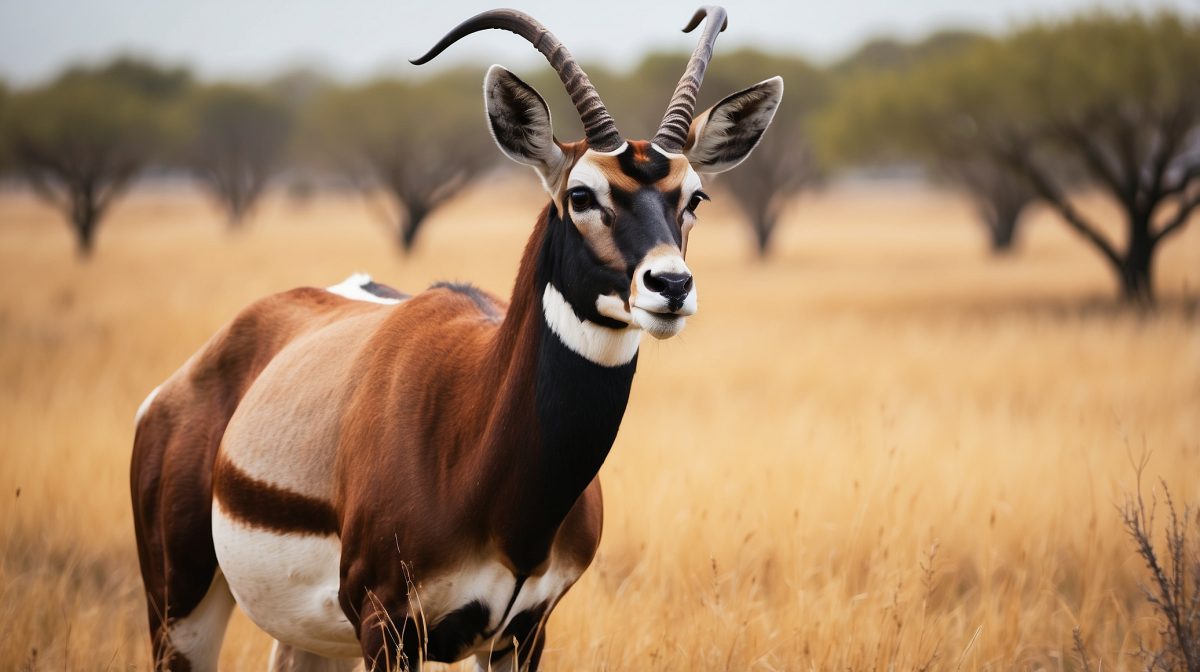The Heritage of the Blackbuck Antelope
Now, the story of the blackbuck antelope is as fascinatin’ as the animal itself. Originatin’ from the Indian grasslands, these critters have found a second home in Texas’s own backyard. It’s a heritage that spans continents and cultures, and it’s a mighty fine example of how nature’s wonders can adapt and thrive in new environments. The introduction of blackbucks to Texas is a tale of vision and careful management, makin’ them a part of our local ecosystem and huntin’ tradition.
The journey from the Indian subcontinent to the Texan plains wasn’t just a hop, skip, and a jump. It took careful plannin’ and a deep understandin’ of the blackbuck’s needs to ensure they’d do well here. And do well they did – today, Texas boasts a robust population of blackbucks, all thanks to the foresight of those who brought ’em here and the continued stewardship of folks dedicated to preservin’ our natural heritage.
Physical Characteristics
Let’s talk about what makes the blackbuck antelope a marvel to behold. First off, their coat – it’s like nothin’ else you’ve seen. The males sport a rich, dark brown back with a stark contrastin’ white belly, and they change colors with the seasons, which is quite the sight in the Hill Country landscape. But it’s not just their coats that catch the eye; it’s those spiralin’ horns that really set ’em apart. For hunters, those horns are more than just a trophy; they’re a symbol of the wild beauty of the blackbuck.
The significance of the male blackbuck’s horns cannot be overstated. These spirals of beauty can reach impressive lengths, and each twist tells a story of survival and strength. They’re not just for show, either – these horns are a key part of the blackbuck’s life, used in battles for dominance and defense. When a hunter sets their sights on a blackbuck, it’s those majestic horns that often draw the most admiration and respect.
Blackbuck Behavior and Habitat
When it comes to behavior, blackbucks are social creatures that live in herds, and they’ve got a hierarchy that’s as intricate as any society. They’re territorial, and the males can get quite feisty durin’ the breedin’ season, which makes observin’ them all the more interestin’. Their adaptation to the Hill Country is nothin’ short of remarkable. These critters have taken to the Texan landscape like cowboys to a rodeo, and they’ve become an integral part of the local fauna.
What makes Texas an ideal home for blackbucks, you might wonder? Well, the rolling hills, open grasslands, and the mild climate here in the Hill Country provide the perfect backdrop for these antelopes. They’ve got room to roam, graze, and do all the things that make blackbucks, well, blackbucks. It’s a testament to their versatility and a boon for those of us who cherish the diversity of our wildlife.
Blackbuck Antelope vs. Other Exotic Game
Now, when you pit the blackbuck antelope against other exotic game in the area, a few things stand out. For starters, their speed and stamina are second to none. A blackbuck can outrun just about any competitor, makin’ them a real challenge for hunters lookin’ for a game that’ll test their mettle. And when it comes to bein’ elusive, blackbucks are as wily as they come. They’re not just gonna wait around for you to take your shot; they’ll make you work for it, and that’s part of the thrill.
What sets huntin’ blackbucks apart from goin’ after other game like axis deer or wild boar? It’s the combination of their agility, intelligence, and the conservation success story behind them. Huntin’ supports blackbuck populations by helpin’ to manage herd sizes and maintainin’ a healthy balance in the ecosystem. It’s a responsible and sustainable way to enjoy the hunt while contributin’ to the well-bein’ of the species.
The Hunting Experience
If you’re wonderin’ what to expect on a guided trophy blackbuck hunt at JL Bar Ranch Resort, let me paint you a picture. You’ll be out there in the crisp mornin’ air, the sun just peakin’ over the horizon, and the whole world holdin’ its breath. With an expert guide by your side, you’ll learn the lay of the land, trackin’ signs and movin’ with a quiet purpose. It’s a dance between hunter and hunted, a respectful pursuit that’s as old as time itself.
Strategies and tips for trackin’ and harvestin’ a blackbuck are passed down like cherished family recipes here in the Hill Country. You’ll learn to read the wind, move silently, and anticipate the blackbuck’s next move. It’s not just about takin’ a shot; it’s about understandin’ the animal and the environment, blendin’ patience with skill, and ultimately earnin’ the privilege to claim your trophy.
Conservation and Management
The role of ranches and hunters in blackbuck conservation is somethin’ we take seriously ’round here. By managin’ populations and habitats, we ensure that future generations can enjoy the same rich huntin’ traditions we do today. Ethical huntin’ practices are at the core of what we do, and their impact on the ecosystem is as beneficial as it is necessary. It’s about respectin’ the land and the creatures that call it home.
When it comes to ethical huntin’, it’s not just about followin’ the rules; it’s about upholdin’ a code of honor that transcends the law. It’s about makin’ sure that every shot counts, that the welfare of the game is always considered, and that the balance of nature is maintained. This approach not only supports the conservation of blackbucks but also enriches the huntin’ experience for everyone involved.
Conclusion
As we round up this little chat, let’s recap the blackbuck’s unique traits and their prized place in Texas huntin’ culture. From their speed and beauty to their role in conservation, the blackbuck antelope is more than just another exotic game – it’s a symbol of our connection to the wild and our responsibility to preserve it. They’re a testament to the success of well-managed wildlife programs and the joy of ethical huntin’ practices.
So, whether you’re lookin’ to bag yourself a trophy or just want to bask in the glory of Texas’s natural bounty, remember the importance of understandin’ and respectin’ this magnificent game animal. The blackbuck antelope ain’t just another critter; it’s a cherished part of our heritage and a thrilling challenge for any hunter. Y’all come back now, and happy huntin’!
FAQs
Why were blackbuck antelopes brought to Texas?
Blackbuck antelopes were brought to Texas for the purpose of exotic game hunting and to diversify the wildlife on ranches and private lands.
What’s the best season to hunt blackbuck antelopes in the Hill Country?
The best season to hunt blackbuck antelopes in the Hill Country is generally the cooler months, from late fall to early spring, when they are more active during the day.
How do blackbuck antelopes differ from native Texas whitetail deer?
Blackbuck antelopes differ from native Texas whitetail deer in their physical characteristics, such as their distinctive horns and coat coloration, as well as their behavior and native habitat.
Can blackbuck antelope hunts be considered conservation efforts?
Yes, blackbuck antelope hunts can be considered conservation efforts when they are conducted ethically and help manage and sustain healthy populations.
What should a first-time hunter know before going on a blackbuck antelope hunt?
A first-time hunter should know the importance of ethical hunting practices, have a basic understanding of the animal’s behavior, and be prepared for a challenging yet rewarding experience.


